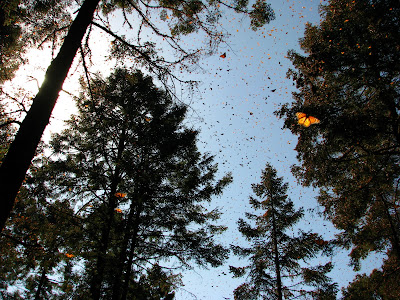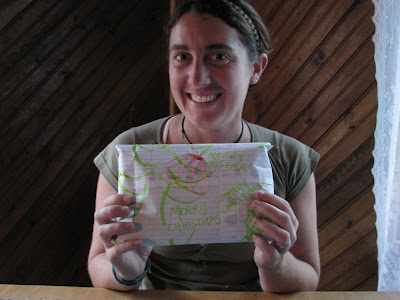Friends and family, brace yourselves. This could be our last post from Mexico! We have covered a lot of ground since I last wrote from southern Mexico. I'll try to pick up where I left off.
In Puerto Escondido we met up with four friends from Idaho who are making their way south. Paul and Camille, and Chad and Rick are on their way to South America. Good luck! Camille is riding the same bike as me, but a few years older. It was fun to have a little bit of home while on the road.

Katie, Mark, Paul and Camille posing in the sunset.

Goodbye breakfast with Team Idaho.
After leaving Puerto Escondido, Mark and I rode north and inland. Since we have already ridden the whole west coast, we thought we'd see what inland Mexico had to offer. From Zihuatanejo we rode into the mountains to the town of Patzcuaro. In Patzcuaro we learned that February was a great time of year to go see the Monarch Butterflies. The warmer temperatures mean you don't have to hike as far up the mountain to see them, and because December and January are the peak season, we had the forest pretty much to ourselves. Being in a forest where the only sound you hear is millions of butterflies flapping their wings is something I cannot describe. It was both strange and beautiful to see the monarchs covering every surface in sight.

Amazing amazing street food in Patzcuaro.

Butterflies covered every tree in sight.

Butterflies in every direction.
We continued our inland journey to Morelia; perhaps the most beautiful city in Mexico. Unfortunately, I was knocked down by a cold while we were there and so didn't explore much of the city. In fact, I don't think we have one single picture from the city. Which is a shame because their historic centro is so well preserved that UNESCO has declared the whole centro a world heritage site.
After Morelia, Mark was pretty excited to get to tequila country. We stayed in the town of Atotonilco las Altas, home to some of the best tequila in the country. We sampled some local brands and the next day we took a tour of the Jose Cuervo distillery in the town of Tequila. We certainly got an education in tequila! I think my dad would have appreciated the details, the subtlety, and the 60 different aromas that practiced tequila tasters can distinguish in one sip of good tequila.

Fields and fields of blue agave just waiting to be made into tequila.

Before the fateful ferry ride.
Tequila country was the end of our inland tour. It was time to head to the coast--Mazatlan, to catch the ferry to La Paz, Baja. The ferry was...quite an experience. We paid $460 for the two of us and the two bikes--a big chunk of money for our tight budget. Now, I am not totally inexperienced when it comes to travel, but I was caught totally off-guard by this ferry. To start, Baja Ferries, the wonderful company who runs this route, claimed that from Mazatlan to La Paz should take 12 hours. The boat was supposed to leave at 4:00 pm and therefore arrive at 4:00 am in La Paz. Wrong. The ferry left over an hour late, and took nearly 17 hours. Those 17 hours felt like 37 hours. Being an overnight ferry, there were cabins available to purchase for sleeping. At 700 pesos each (about $65 dollars) this was an expense we could not afford after paying for our tickets. We thought we would just claim a couple seats and hole up somewhere for the night. Wrong again. There were no seats. That's right, on a 17-hour ferry ride, there were no chairs, no passenger areas, no nothing. There were a couple benches out on the deck (cold and windy!) and a miniscule cafeteria with a few tables and chairs. Since those of us on motorcycles boarded last, by the time we got to the cafeteria every chair, table, space was quickly claimed with blankets, backpacks, and jackets. Did I mention that 95% of the passengers on this ferry were truckers? And, in case you were wondering, truckers in Mexico are the same breed as truckers in the states. So for everyone who could not afford or reserve a cabin (oh yeah, they were sold out too) the two options for the next 17 hours were a bench out on the deck or a spot in the crowded cafeteria. There you have the scene for our next 17 hours. Over the next couple hours a bad meal was served, and lots of beer was drank. Lots and lots and lots. Lots of beer, lots of men, and very cramped quarters. Can you guess what happened? Yep, fights. Not a fight, fights, two of them. In which punches and chairs were thrown in the cafeteria. Also, some shit-talking, which perhaps led up to the fights. It made for a very uncomfortable situation in the cafeteria. Mark and I alternated between laying on chairs (and trying to sleep) in the cafeteria, and laying on the floor of the deck outside near the exhaust, where it was warm but smelled like diesel.
Like I said, we survived, and even made a friend, Lars, whom we have been traveling the last few days with.

A cold boat ride to go whale watching.

All dressed up and ready to ride the Baja with Lars. Its freaking cold here!
We are about half-way up the Baja now, and planning to hit Arizona early next week. I have an interview scheduled for March 10 in Salt Lake. Talk about taking the fast track back to reality. So, for those of you who are wondering, we will be back in Salt Lake a couple days before March 10. Until then..




























































